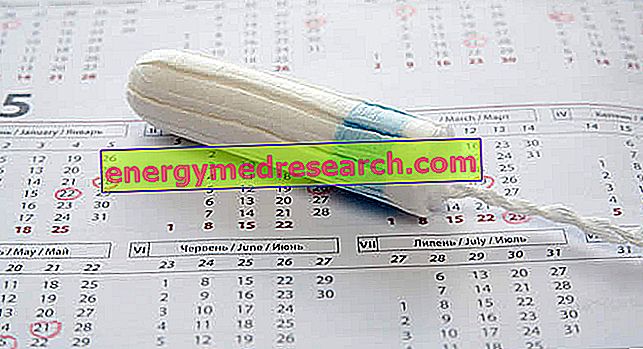Watch the video
X Watch the video on youtubeIntroduction
From puberty to menopause, the female reproductive system undergoes a series of structural and functional cyclical changes, which are repeated every month. These changes - directly related to the woman's reproduction and fertility - determine the so-called menstrual cycle .
The latter represents an indicator of a woman's health; therefore, it is useful to understand how it works and keep it under control to recognize its irregularities. Knowing how to calculate the menstrual cycle also allows you to identify which are the most fertile days when trying to have a baby or if you wish to avoid a pregnancy.

Duration and frequency of the menstrual cycle
The menstrual cycle is the time interval between a period and the next.
To calculate the duration, the period from the first day in which the menstrual flow appears (1st day of the cycle) to the day before the next menstruation starts must be considered.
In the case of a regular 28-day cycle, ovulation (when the ovary releases the egg) takes place 14 days before the start of the next menstrual flow.
Menstrual cycle or menstruation? In common parlance, the term "menstrual cycle" is often used improperly to indicate menstruation, ie the blood loss that occurs every month and lasts on average from 3 to 7 days.
Do all women have regular cycles?
A menstrual cycle is considered physiological when repeated at regular intervals of 28 days. However, it is normal to consider a menstrual frequency of 25 to 36 days and a certain individual variability (the duration of the cycle can change from month to month).
In any case, to be considered regular, between one menstrual period and another, there must not be a "gap" exceeding 4 days (more or less).
Possible variations in the duration of the menstrual cycle are more likely to depend on the length of the period preceding ovulation (follicular phase). This first phase of the cycle, despite having an average duration of about 14 days, can in fact undergo fluctuations, ranging from 1 to 3 weeks.
| Menstrual cycle: rhythm, quantity and duration | |
| Frequency | 28 days (25-36 days) |
| Menstruation | Duration 3-7 days |
| Blood loss | 28-80 ml |
For most women, however, the luteinic phase (from ovulation to the beginning of menstruation) is more constant and takes from 12 to 16 days (average duration: 14 days).
The regularity of the menstrual cycle is linked to a precise hormonal control of the phenomenon, in which hypothalamus, pituitary glands and ovaries participate. The major variations in the length of the cycle occur in the first years after the menarche and in the premenopause.
Why do women have the cycle?
During the menstrual cycle, a series of processes occurs, the purpose of which is the maturation of an egg cell and the preparation of a fabric suitable for its implant. In other words, these events set the stage for the eventual pregnancy, if fertilization by a sperm of male origin occurs.
All these processes are associated with the periodic and regular secretion of the ovarian, hypothalamic and pituitary hormones, directly related to fertility.
Therefore, different body structures (central nervous system, hypothalamus, pituitary and ovary) contribute to maintaining the menstrual cycle.
What happens during the menstrual cycle
The menstrual cycle is an event that occurs during the woman's reproductive life, from puberty to menopause.
Menses

In general, menstruation lasts 3-7 days.
Ovulation preparation
During the first part of the menstrual cycle, the pituitary gland initiates the secretion of the follicle-stimulating hormone (FSH), which stimulates the maturation of a "dominant" egg cell.
At the same time, estradiol levels (produced by the ovary) increase progressively in the blood. This determines a progressive thickening of the endometrium, which is thus prepared to receive the mature egg cell if it is fertilized.
Ovulation
Around the 14th day of the cycle, a sharp increase in the luteinizing hormone (LH) causes the ovarian follicle to rupture, with the consequent expulsion of the mature oocyte into the fallopian tube (ovulation).
During the 24 hours following this event, the egg cell is available for the eventual encounter with the spermatozoa. The release of the oocyte is therefore a fundamental prerequisite for conception.
After ovulation
Immediately after ovulation, what remains of the "burst" follicle is transformed into the corpus luteum, which produces progesterone, a hormone necessary for the first stages of a possible pregnancy, which further thickens the endometrium.
- When conception does not occur, progesterone levels fall rapidly due to functional depletion of the corpus luteum. This triggers the phenomena that will lead to the exfoliation of the uterine wall and the subsequent menstruation.
- Otherwise, the fertilized egg cell lurks in the uterus, where it finds the most favorable environment for its implantation and the continuation of the pregnancy.
Fertile days
In every menstrual cycle, the most favorable moment for conception coincides with ovulation and with the days in the vicinity of this event.
Generally, if the woman has regular cycles, this process occurs approximately every 28 days. After the onset of menstruation, in fact, an oocyte (one for each menstrual cycle) takes on average 14 days to mature and, under the hormonal stimulus, escape from the follicle that contains it to enter the tuba. From here, the egg cell begins its journey towards the uterus where it nests if, in its path, it is fertilized by a spermatozoon.
Indicatively, the period in which it is possible for the egg to be fertilized starts 4-5 days before ovulation and ends 1-2 days later . This is possible in view of the fact that the mature egg cell when it is expelled from the ovary manages to survive for about 24 hours, while the spermatozoa can remain viable in the female genital apparatus up to 72-96 hours from intercourse.
Changes in the menstrual cycle
Menstrual cycle irregularities can have many different causes, including:
- Pregnancy or breastfeeding;
- Eating disorders, sudden weight loss or increase and excessive physical activity;
- Polycystic ovary syndrome (PCOS);
- Early ovarian failure;
- Pelvic inflammatory disease (PID);
- Uterine fibroids.
In case of alteration or interruption of the menstrual cycle (previously regular), it is advisable to consult a doctor.
| Main alterations of the menstrual cycle | |
| Rhythm less than 25 days (short cycles, with close flows) | polymenorrhea |
| Pace over 36 days (long cycles, with spaced flows) | oligomenorrhoea |
| Absence of menstruation for at least 3 months | Amenorrhea |
| Excessively abundant menstrual blood loss, of a haemorrhagic nature, and / or of a duration longer than normal | Menorrhagia |
| Abundant menstruation that is prolonged even in the intermenstrual period | Menometrorragia |
| Blood loss that occurs independently of menstrual flow or at a time when there should be no menstruation (pregnancy, menopause or before puberty) | Metrorrhagia * |
| Menstrual blood loss less than 20 ml (menstrual flow less than normal) | hypomenorrhea |
| Menstrual blood loss greater than 80 ml (heavy menstrual flow) | hypermenorrhea |
Menstrual cycle calendar
Monitoring menstrual cycles can help you understand what is normal, what are the most fertile days and how to identify important irregularities that can sometimes indicate health problems.
To do this, you can use a calendar.
Taking note of the onset of menstruation monthly helps to identify the approximate beginning of the next menstrual flow. This allows you to be prepared for the onset of blood loss and to understand which are the most fertile days, or at which time conception is most likely.
In practice, from the first day in which the flow appears, many days must be counted as the average duration of one's cycle (eg 28 days), so in the calendar it must be marked with a pencil on the day on which menstruation is expected next one.
For the compilation of an even more detailed calendar, it is also possible to note all the symptoms that occur during the entire menstrual cycle, such as breast tenderness, cramps, headache, back pain, mood swings, sleep disorders, fatigue, swelling or upset stomach.



